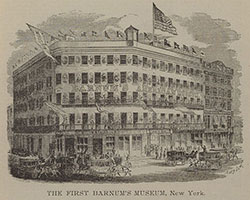 Nowadays, most museums are large public institutions created for the purpose of educating people about specific areas of interest such as art, science, and natural history. Experts run these museums. They are well organized. And their information is accurate.
Nowadays, most museums are large public institutions created for the purpose of educating people about specific areas of interest such as art, science, and natural history. Experts run these museums. They are well organized. And their information is accurate.
But in [P.T.] Barnum’s day there were no large public museums. Instead museums were owned by individuals who set up their own displays, then charged the public an admission price. The first person in America to do this was Charles Willson Peale, painter, inventor, and nature enthusiast. Peale founded a museum in Philadelphia in 1784 with the purpose of “bringing together objects that might be helpful in advancing knowledge.” He tried hard to create scholarly exhibits. Natural history displays such as stuffed birds and reptiles skeletons were arranged according to scientific principles, and some specimens were even placed in replicas of their natural habitats. “Can the imagination conceive anything more interesting than such a museum?” Peale asked. Other would-be museum owners soon began imitating Peale. By the beginning of the nineteenth century, almost every major city had such an establishment.
But these museums soon faced stiff competition from other forms of amusement. Small circuses, touring artists, and theaters began grabbing the public’s interest. People stopped coming to the museums, with their quiet, never-changing, educational exhibits. Museums tried to evolve with the times. Even Peale added “curiosities,” such as a two-headed calf and a chip from Queen Victoria of England’s chair. But it wasn’t enough to recapture the public’s attention. By 1840. most of the country’s museums were going bankrupt.
That’s when Barnum stepped in. Fun came first, and the showman looked for displays that appealed to popular tastes, adding them to his collection in a hodgepodge: giant balls of string next to fossils; ancient coins next to a clear circus. Some artifacts were fake, others were labeled incorrectly, and none included any information about their historical or cultural significance. Later, to compete with theaters and traveling artists, he added live performers, a zoo, and even an aquarium. Americans had never seen anything like it. Wrote the historian A.H.Saxon, “Barnum changed the meaning of the word museum in the mid-nineteenth century. Now it had become the name for any building that contained a variety of exhibits and entertainments.”
From The Great And Only Barnum by Candace Fleming, pages 32–33.

